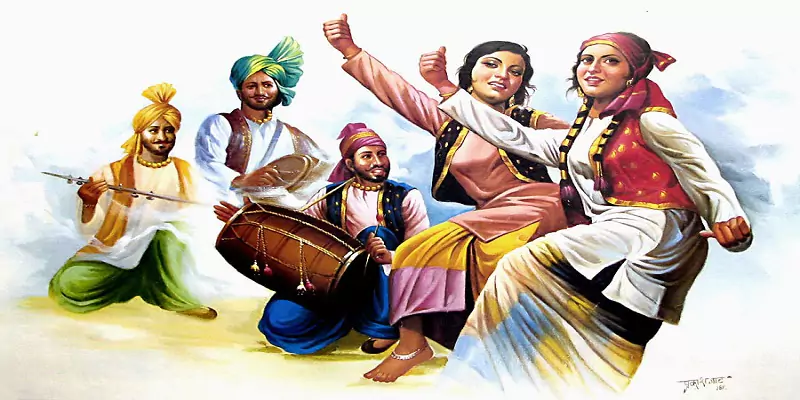Punjabi Culture
Punjab, the land of five rivers, is not just a geographical region but a vibrant cultural mosaic that has flourished over centuries. Encompassing a significant part of Pakistan, Punjabi culture is a fascinating blend of traditions, language, music, dance, and cuisine. Rooted deeply in history and shaped by diverse influences, Punjabi culture stands as a testament to the resilience and richness of the people who call this region home.
At the heart of Punjabi culture lies the Punjabi language, spoken by a large population in both Pakistan and India. The language has a rich literary tradition dating back to ancient times, with notable poets like Bulleh Shah and Waris Shah contributing significantly to Punjabi literature. The lyrical and poetic nature of the language reflects the cultural ethos of the region, with its emphasis on love, spirituality, and the everyday lives of its people.
The traditional attire of Punjabi men and women adds a burst of color to the cultural landscape. Men often don the distinctive Punjabi kurta, paired with a lungi or dhoti, and top it off with a colorful turban. Women, on the other hand, wear vibrant salwar kameez or lehenga choli, complemented by intricate dupattas. The use of bright colors and intricate embroidery reflects the celebratory spirit ingrained in Punjabi culture.
Punjabis are known for their exuberant celebrations, and the festivals they observe are a testament to their joyous spirit. Baisakhi, the harvest festival, is celebrated with fervor, featuring traditional dances like Bhangra and Giddha. Lohri, another winter festival, is marked by bonfires, singing, and dancing, symbolizing the triumph of light over darkness. These festivals not only bring communities together but also showcase the cultural unity and shared heritage of the Punjabi people.
Punjabi music, with its infectious beats and lively tunes, has gained international acclaim. Bhangra, a traditional dance form, has become synonymous with Punjabi culture and is performed at various celebrations. The beats of the dhol, accompanied by the energetic moves of the dancers, create an electrifying atmosphere. Punjabi music has evolved over the years, with contemporary artists blending traditional tunes with modern genres, ensuring its popularity across generations.
No discussion of Punjabi culture is complete without mentioning its delectable cuisine. Punjabi food is known for its bold flavors, generous use of spices, and hearty dishes. The quintessential Punjabi meal includes dishes like butter chicken, sarson da saag (mustard greens), and makki di roti (cornbread). The cuisine reflects the agrarian roots of the region, with an emphasis on locally sourced ingredients and robust flavors.
The architectural heritage of Punjab is a visual feast, showcasing a blend of Mughal, Sikh, and British influences. The Badshahi Mosque and Lahore Fort in Lahore are iconic landmarks that reflect the grandeur of Mughal architecture. The Golden Temple in Amritsar, a sacred site for Sikhs, is another architectural marvel that attracts visitors from around the world. These structures not only serve as historical monuments but also embody the cultural and religious diversity of the region.
Punjab is a melting pot of religious diversity, with significant populations of Muslims, Sikhs, and Hindus. This diversity is evident in the religious festivals, rituals, and places of worship that dot the landscape. The coexistence of different religious communities has contributed to the rich tapestry of Punjabi culture, fostering a spirit of tolerance and harmony.
Punjab is characterized by a unique blend of rural and urban lifestyles. While urban centers like Lahore and Faisalabad are hubs of commerce, education, and modernity, the rural areas maintain a strong connection to agrarian traditions. The lush green fields of Punjab, known as the 'Granary of India,' not only contribute significantly to the nation's agricultural output but also shape the way of life for many Punjabis.
While Punjabi culture continues to thrive, it faces challenges in the modern era. Globalization, urbanization, and changing social dynamics pose threats to the preservation of traditional practices and values. Efforts to safeguard and promote Punjabi culture include initiatives to document oral traditions, support local artisans, and encourage the teaching of Punjabi language and literature.
Punjabi culture in Pakistan is a vibrant and dynamic tapestry woven with the threads of history, traditions, and diverse influences. From the lyrical poetry of Bulleh Shah to the pulsating beats of Bhangra, from the aromatic flavors of Punjabi cuisine to the majestic architecture of historical landmarks, Punjab offers a multifaceted cultural experience. As the people of Punjab navigate the challenges of the modern world, their commitment to preserving and celebrating their rich heritage ensures that Punjabi culture will continue to flourish and captivate generations to come.

